We often strive to put colors in our planting designs, in the use of both foliage and flower. But are different colors essential? If we skillfully choose and combine plants, a monochromatic green palette can give us just as much interest as flowers with different colors.
And could green also provide the same neutral benefits as gray, another popular color for both home and landscape? In the garden many people tend to use gray because its neutrality makes for the perfect background for a wide range of flowers, perhaps most famously exemplified in the gray gardens at Sissinghurst in Kent, England. But how often have you seen a garden dedicated to green? The color green is a perfect neutral, because it is neither a warm or a cool color, having equal parts of yellow, which is warm, and blue, which is cool. This balance makes it a calming and restful color — perfect for creating those stress-busting outdoor spaces.
Let's look at some techniques of planting design that will help you successfully focus on green.
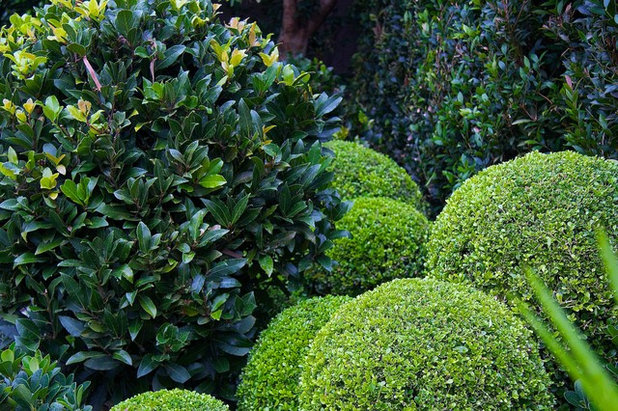
Art in Green
1. Use a variety of foliage. Vary not only the tone of green but also the foliage finish — from dull matte to deep shine. The boxwood (
Buxus sempervirens) shown here, with its dull, clipped foliage, contrasts the dark green polished leaves of the
bay (
Lauris nobilis), for a simple planting mixture.
Notice the wonderful shading on the side of the boxwood balls; they change color as the light changes.
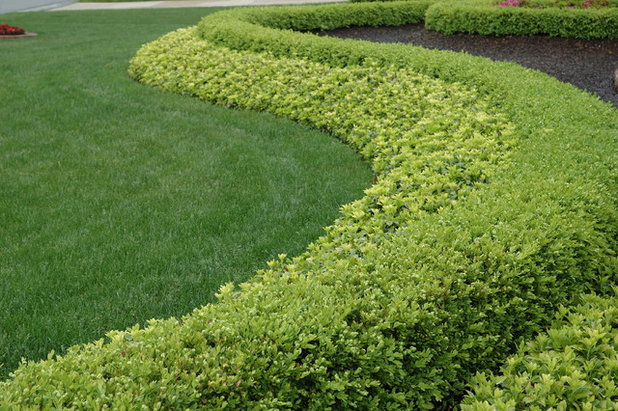
Land Architects, Inc.
The use of just two plant species against a closely mown lawn shows how clever use of both tone and texture can provide just as much interest as a flowering border.
Clipped boxwood was used here, allowing the fresh lime-green growth to contrast the shiny foliage of the Japanese spurge (
Pachysandra terminalis).
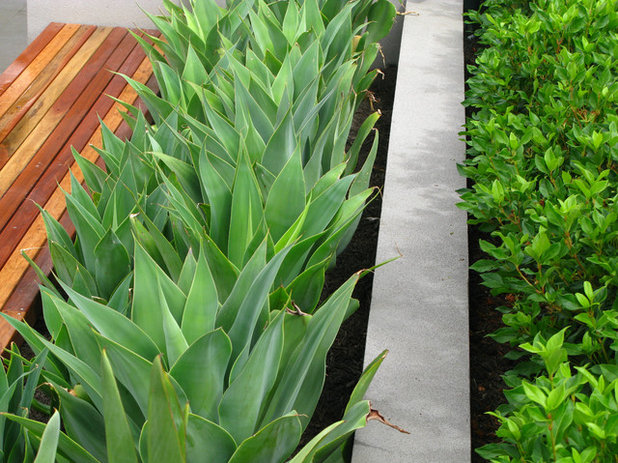
Tim Davies Landscaping
2. Mix foliage texture. Notice here how the designer contrasted the texture of the different foliage — the matte spikiness of the agave against the shiny gloss of the
Laurustinus (
Viburnum tinus)
.A monochromatic green planting fits contemporary gardens perfectly. The neutral nature of the color does not detract from the design or the hard landscaping material.
More tips on mixing foliage texture
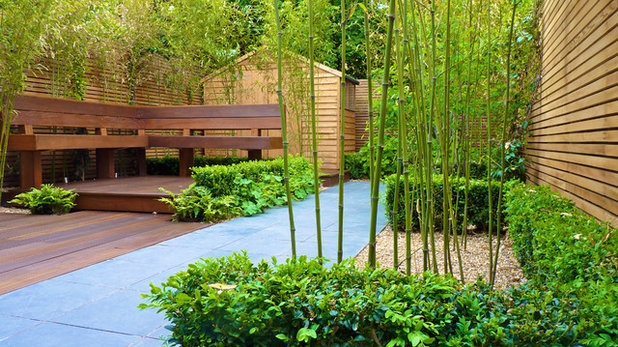
Cityscapers
3. Vary shapes and sizes. It's always important to vary the shapes and sizes of plants in garden design, but it's vital in a green-only garden. This small, modern London town garden is a great example of how to combine different plants to create an interesting and satisfying scheme.
The green bamboo stems and foliage give height yet allow a view through to the upper limits of the garden, while the mass of low-clipped boxwood and clumps of Skimmia perfectly balance the plantings with the formal hard landscaping.
Ferns at selected points lighten the whole design, bringing differences in shade of green, leaf texture and height of growth.
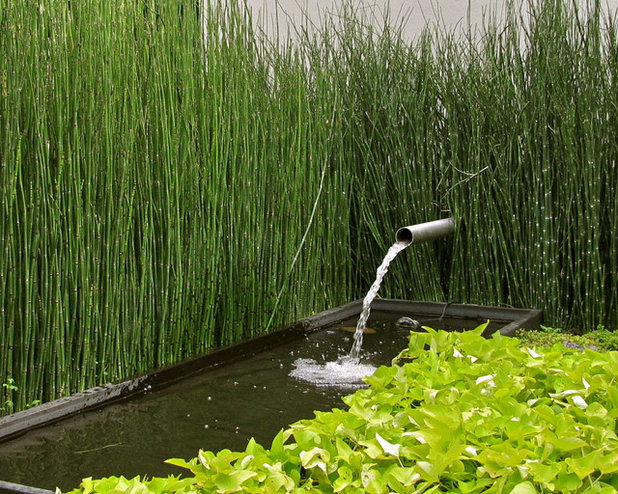
A Pleno Sol
Even in a small area of monochromatic planting, like the one surrounding this trough water feature, plant height and foliage form are important.
Here the tall, dark green spikes of
horsetail (
Equisetum spp) perfectly contrast the low, scrabbling growth of the fluorescent lime-green
Ipomoea.
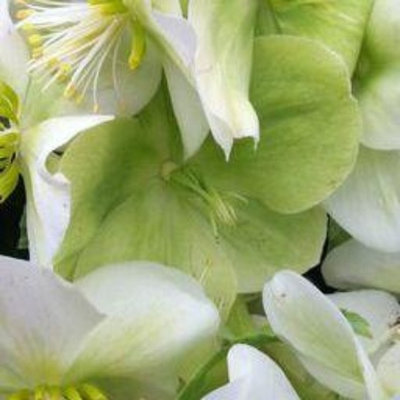 4. Complete the picture with green flowers.
4. Complete the picture with green flowers. There are green flowers, for those of you who would have withdrawal symptoms in a garden without flowers, but they are few and far between. The benefit of using only green foliage in a planting is that, like gray, it is a great neutral background on which to overlay other colors. There are, though, quite a few flowers with a tinge of green as their flowers mature to another color, mainly to white, which works especially well against green foliage.
Winter- and spring-flowering
Hellebores not only have deeply cut, dark green leaves that fit nicely into a green planting palette, but some varieties show green coloring in their maturing flowers.
Helleborus niger, the Christmas Rose, has white flowers that start off as the palest of lime greens before maturing to a clean white. The variety 'Christmas Carol' is one of the best for producing this immature green inflorescence.
The Hellebore with the most convincing green flowers is
H. foetidus, the Stinking Hellebore, which has tall spires of lime-green flowers held above spiky, deep green foliage.
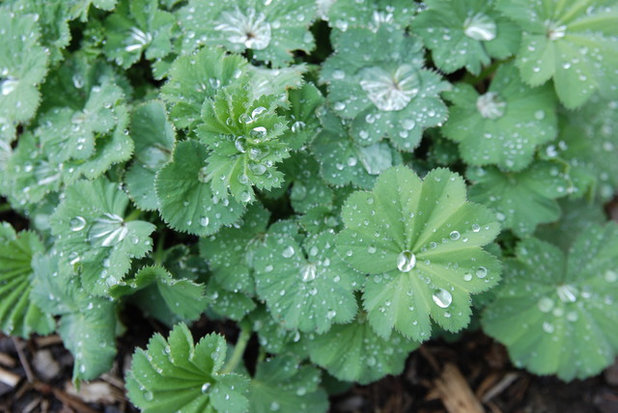
Paintbox Garden
Lady's mantle (
Alchemilla mollis) is a perfect herbaceous perennial to use in a green garden. It produces clumps of hairy, light green leaves that charmingly, as shown, hold drops of water after rain. Its flowers are an acid green and fit beautifully with any green theme. (Beware: It seeds freely.)
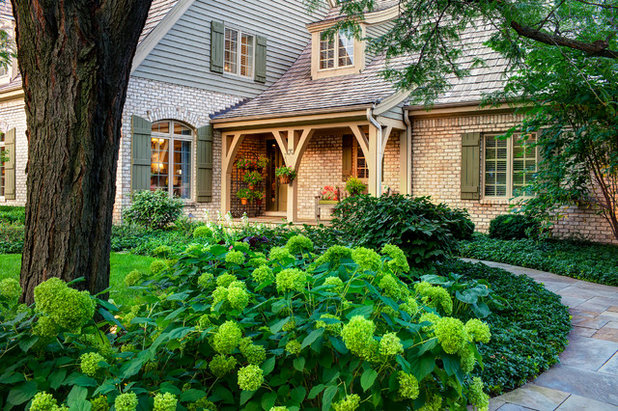
Hursthouse Landscape Architects and Contractors
Some
hydrangeas have green-tinged immature flowers that will hold their green color, like this
Hydrangea arborescens 'Annabelle'. Once mature, the panicles of flowers turn white.
Hydrangea paniculata 'Limelight' is another variety that also produces similar blooms; lime-green flower heads turn creamy white on maturing.
The underplanted ground cover here is Japanese spurge (
Pachysandra terminalis), a useful ground-cover plant that can cope with dry shade. The best variety to look for is 'Green Carpet', which has glossy deep green leaves.
Other green flowers to try include
Bells-of-Ireland (
Moluccella laevis) and the
European snowball viburnum (
Viburnum opulus 'Roseum'), which have flowers that are green in the immature stage before maturing to white.
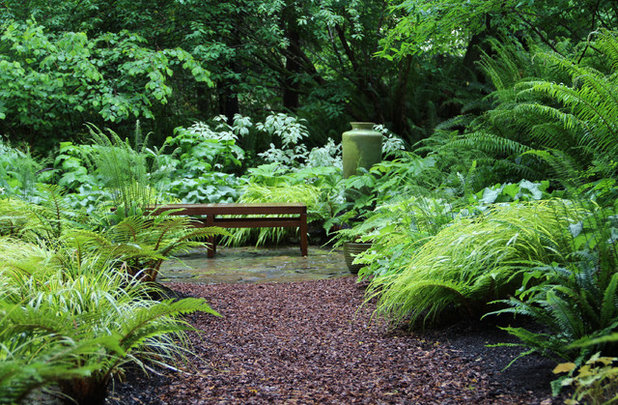
Bliss Garden Design
All-Green Garden ExamplesThis shade garden shows all the attributes of a successful monochromatic green garden: variation in foliage color, contrasting textures and a mixture of foliage shapes and sizes.
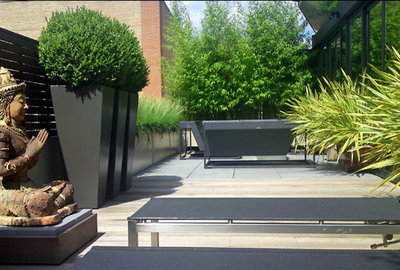
MyLandscapes
In contrast with the previous tranquil woodland garden, this contemporary London town garden employs all the same monochromatic planting skills.
Though there is a minimal plant material in the design, there is once again a creative mixture of foliage colors, leaf textures and foliage and plant shapes.
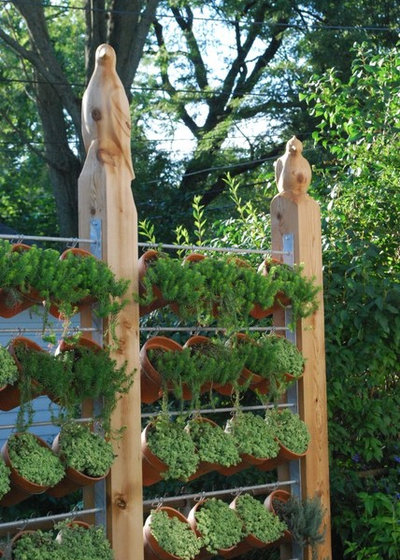
Art | Harrison Interiors & Collection
Is this the simplest monochromatic green garden? A minimalist green wall has been created with terra-cotta pots, planted with a selection of sedums with a variety of green foliage.





